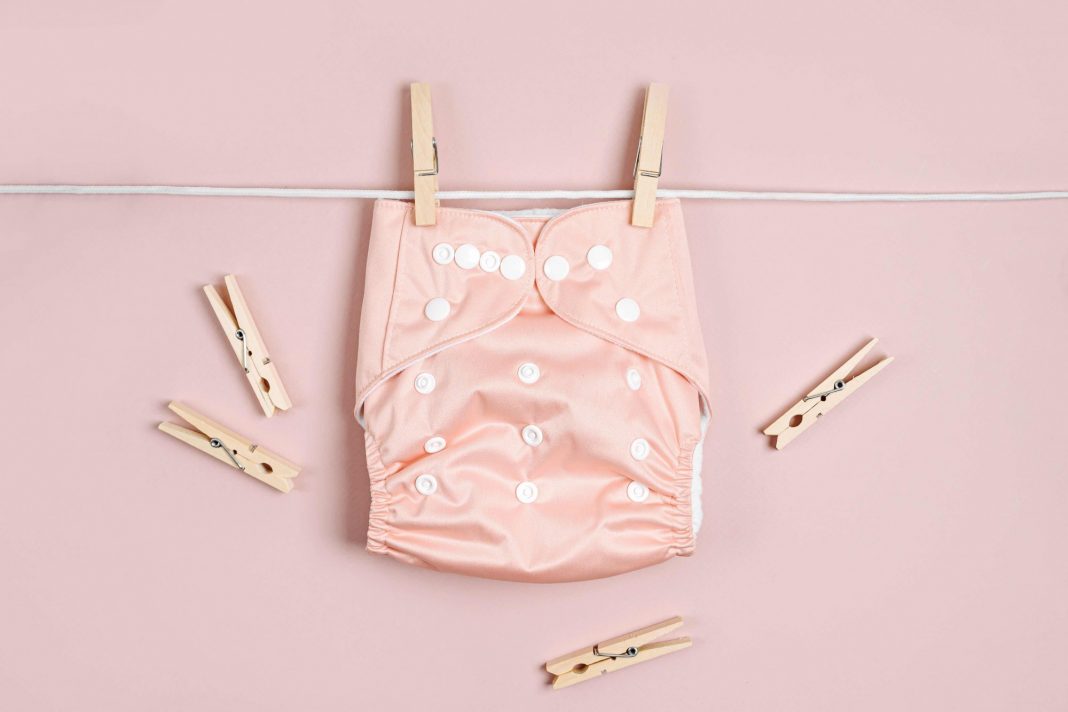A question I’ve been asked many times over the past two years is ‘why?’ It’s usually followed by, ‘but how do you clean them – isn’t it gross?’ These questions arise when someone finds out that I opt for modern cloth nappies (MCNs) instead of disposables for my son.
MCNs are washable, reusable cloth nappies that have been sewn into a preformed nappy shape. Most feature snaps or hook-and-loop fasteners, meaning they can be easily put on (without the folding and pinning of traditional terry flats). Most also have adjustable ‘rise snaps’, meaning it’s possible for the same nappy to fit from birth to toilet training.
While MCNs have been around for many years, with most products bought online, they’re now more readily available thanks to ranging in some of Australia’s biggest retailers. ALDI was one of the first, partnering with Australian brand Bare and Boho to bring out a number of MCNs, reusable swim nappies and accessories as part of its special buys.
Woolworths has since followed suit, ranging various reusable products from Bare and Boho, Designer Bums, Eco Naps and Pea Pods. Even Kimberly-Clark, the manufacturer of popular disposable nappy brand Huggies, has identified the opportunities around reusable products and introduced Huggies Little Swimmers Reusable Swim Nappy.
MCN adoption, while growing, remains a drop in the ocean compared with disposable nappy sales. However, with every reusable nappy capable of replacing hundreds of disposable products, it’s certainly a trend worth monitoring. By understanding the needs and habits of MCN families, you may find new opportunities to support your customers.
Why cloth?
In 2019, the Australian Nappy Association surveyed 2453 cloth nappy parents to find out how and why they opt for reusable nappies. The ‘Great Australian Cloth Nappy Survey’ found that 63.7 per cent of surveyed cloth nappy parents opted for reusables due to a desire to reduce their environmental impact. Saving money (21 per cent) and ‘better for baby’ (14.7 per cent) were other popular reasons given by those surveyed.
Another factor I’ve noted being discussed on several MCN online forums emerged in early 2020. Pandemic panic buying left many parents uncertain whether they’d be able to buy disposables when they needed them. For those using cloth, even part-time, this was one less thing to stress about.
(On a related note, I’ve also read accounts of some cloth nappy families making the switch to reusable toilet paper during the pandemic and beyond – if you’re already washing cloth for a baby, what’s a few extra items from the rest of the family?)
According to the Australian Nappy Association survey, 68.7 per cent of cloth nappy parents interviewed also use cloth wipes.
Education and support
Parents are overwhelmingly finding out about cloth nappies from friends and family (49.8 per cent of respondents), according to the Great Australian Cloth Nappy Survey, with online research and social media also playing important roles (25.3 and 15.3 per cent). This has likely been shifting in recent years, with ranging in mainstream physical stores improving product visibility.
Local government councils in Australia are also boarding the cloth nappy train. Many councils host seminars to introduce residents to cloth nappying, and some offer rebates to encourage trial.
Plenty of resources are available online to help people on their cloth nappy journey. Clean Cloth Nappies is the largest cloth nappy Facebook group in Australia, New Zealand and the UK, with more than 86,000 members. Its team of volunteer administrators help answer questions and troubleshoot problems on a wide range of issues, including detergents, wash cycles and treating stains, smells or mould.
Other substantial Facebook groups in the cloth nappy community include MCN Tips & Tricks (21,000-plus members) and Buy & Sell your Modern Cloth Nappies Australia (30,000-plus members).
There’s even a podcast run by Australian cloth nappy experts, Nappy Leaks. Running since 2018, its episodes offer great insights for those starting out as well as those well into their cloth journey.
Keep ’em clean
Cleaning cloth nappies is not the horror, or time-consuming process, that many might think. Soaking is generally discouraged, mainstream detergents are recommended, and your washing machine does all the hard work.
Here’s a general guide of what to expect:
- Pretreat. Rinse/flick any solids into the toilet. You don’t want these in your machine. Optional: if you’re concerned about stains, you can rub a laundry soap into the fabric. Leave nappies in a dry pail until ready for the next step (within two days).
- Prewash. A short machine wash cycle (30-60 minutes) using warm to hot (40-60°C) water. This will rinse out excess soiling, ensuring your main wash is completed with clean water. Once completed, store damp nappies in a dry pail to await the main wash (within two days).
- Main wash. Using the longest cycle on your machine (2-3 hours for top loaders, 1-2 for front loaders), wash nappies in warm to hot (40-60°C) water.
- Dry nappies. Outdoors, indoors or in the tumble dryers are all options, depending on the fabrics. Dry times can also vary: covers/shells can dry as quickly as within 15 minutes in a light breeze, while insert dry times are converse to their absorbency (microfibre holds less, but dries substantially quicker than hemp, while cotton and bamboo are in between).
Retail opportunities
Whether or not your pharmacy sells MCNs, a variety of accessories, possibly already ranged on your shelves, that could be promoted to support those using cloth.
Laundry detergents, unsurprisingly, are a big one. The extra washing means cloth parents tend to use more detergent than the average person, so buying in bulk and/or when on promotion is highly appealing.
An interesting phenomenon that affects some people is being turned off their usual detergent because they begin associating the fragrance with dirty nappies.
A popular tip floated on social platforms is to cycle between different detergents to prevent this from happening.
For retailers (and suppliers) this means that cloth families may be less brand loyal and more open to switching than other shoppers.
Laundry soap and boosters are great for treating stains. Bleach, while not recommended for regular use by most MCN manufacturers, can be used in a ‘strip and sanitise’ – a deep cleaning process recommended for second-hand nappies, or when a poor wash routine leads to ammonia buildup.
Plastic laundry baskets, aside from their intended use, make for great dry pails – storage for nappies awaiting a wash. Gone are the days of nappies being soaked before washing.
MCN users are encouraged to place wet/dirty nappies into a dry pail to preserve the life of the nappies, eliminate odours (which are quickly dispersed in the air thanks to good air flow), prevent mould, reduce the need for extra effort, and eliminate the drowning hazard of water lying around the house.
With big loads of washing come big piles to dry. While clothes dryers can be used on inserts (not shells, which are sensitive to heat), the green-leaning, cost-cutting persuasion of the typical cloth parents means that air drying tends to be the favoured means when possible.
Shells are best dried indoors or in the shade, as the waterproofing layer can be degraded by heat or sun.
Portable clothes horses/airers are great for this. Peg octopuses/sock hangers are also popular solutions for liners and wipes, as they can hold numerous small items and be brought inside quickly if it rains or moved around to chase the sun.
Buckets, gloves and other items can aid in poo removal. While modern nappy cleaning recommendations eliminate a lot of pre-treating to simplify the process – and dirty nappies from exclusively breastfed bubs can go straight into the machine, as their waste is water-soluble – a cloth parent will inevitably have to remove a not-so-solid poo from a nappy at some point.
Poo removal solutions are an oft-talked-about topic on MCN forums. Some of the most popular options include scraping with a silicon dish brush, spatula or pet hairbrush, installing a bidet spray, or popping on some gloves and shaking the nappy in a bucket of warm water.
Those using cloth wipes – either in conjunction with cloth nappies or with disposables – sometimes also seek accessories. These can include spray bottles or water bottles for wetting cloths as needed (thermal-insulated vessels can ensure warm wipes for pampered bums or during winter), or leak-proof bags or containers to store pre-wet wipes.
A matter of change
The cloth nappy market is incredibly diverse, with families opting to replace some, or all, of their nappy spend on reusables – for countless reasons. Rather than seeing the emerging market as a challenge to the established disposable nappy category, retailers should consider the opportunities that come with showing their customers they care about their choices.
This feature was originally published in the May issue of Retail Pharmacy Assistants e-magazine.






